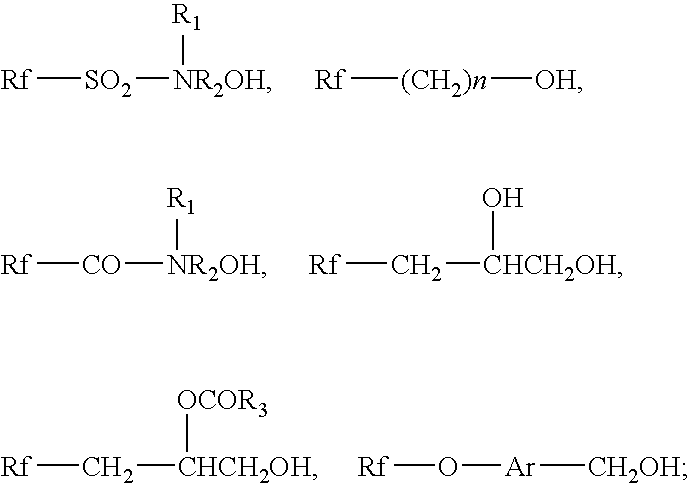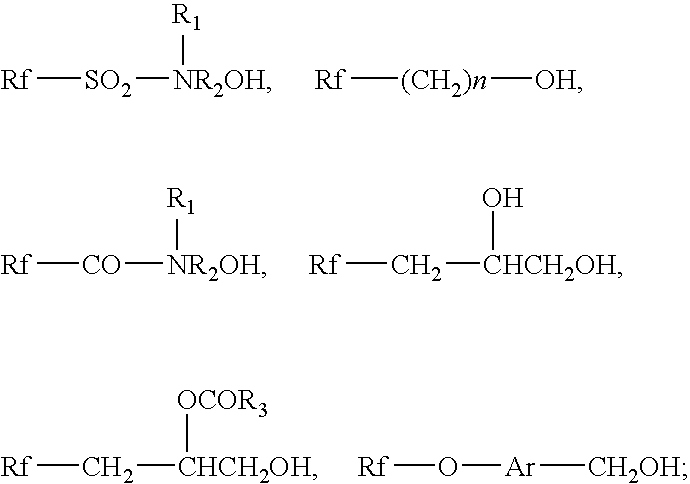Solvent-based fluorinated water and oil repellent and process for producing the same
a technology which is applied in the direction of liquid repellent fibres, fibre treatment, physical treatment, etc., can solve the problems of limited application, unstable emulsion particles of fluorinated water and oil repellent products currently available, fire hazards, etc., and achieve excellent water and oil repellency, superior stability and physical properties, and wash durability. the effect of durability
- Summary
- Abstract
- Description
- Claims
- Application Information
AI Technical Summary
Benefits of technology
Problems solved by technology
Method used
Image
Examples
example 1
[0041] Place 24.75 g of trimethylol propane into a 2L glass reactor equipped with an agitating device, vacuum motor, a thermometer, and cooling device. First, vacuum the reactor and purge with nitrogen to replace air 30 minutes later. Then add 123.75 g of IPDI into the glass reactor and raise the temperature to 85˜90° C. After maintaining the reactor temperature for 2 hours, start measuring the percentage of NCO. When the percentage of NCO reaches 16-18%, add 231 g of CF3(CF2)7(CH2)2OH and raise the temperature to 95° C. Let the reaction continue to 4 hours and start measuring the percentage of NCO. When the percentage of NCO reaches 1.5˜2.0%, add 325.5 g of butanone and maintain the reactor temperature under 70±3° C. for 10 hours. Subsequently drop the temperature to 50±3° C., then add 15 g of butanone oxime and let the reaction continue for 1 hour. Afterwards, add 600 g of butanone and 150 g of butyl acetate and mix for 30 minutes. Following polymerization reaction, the resulting ...
example 2
[0042] Place 24.5 g of trimethylol propane into a 2L glass reactor equipped with an agitating device, vacuum motor, a thermometer, and cooling device. First, vacuum the reactor and purge the reactor with nitrogen for 30 minutes to replace air. Then add 29.5 g of HDI and 85 g of IPDI into the glass reactor and raise the temperature to 85˜90° C. After maintaining the reactor temperature for 2 hours, start measuring the percentage of NCO. When the percentage of NCO reaches 16-18%, add 231 g of CF3(CF2)7(CH2)2OH and raise the temperature to 95° C. Let the reaction continue to 4 hours and start measuring the percentage of NCO. When the percentage of NCO reaches 1.5˜2.0%, add 320 g of butanone and maintain the reactor temperature under 70±3° C. for 10 hours. Subsequently, drop the temperature to 50±3° C., then add 15 g of butanone oxime and let the reaction continue for 1 hour. Afterwards, add 400 g of butanone and 350 g of ethyl acetate and mix for 30 minutes. Following polymerization re...
example 3
[0043] The materials, weights and polymerization processes in this example are identical to those in Example 1, only the material used in the second-stage polymerization CF3(CF2)7(CH2)2OH is replaced by the mixture of 105 g of CF3(CF2)7(CH2)2OH and 112.5 g of CF3(CF2)6(CH2)2OH. Following polymerization reaction, the resulting polymer dispersant weighed 1456.5 g with solid content of 24.1%.
PUM
| Property | Measurement | Unit |
|---|---|---|
| temperature | aaaaa | aaaaa |
| temperature | aaaaa | aaaaa |
| temperature | aaaaa | aaaaa |
Abstract
Description
Claims
Application Information
 Login to View More
Login to View More - R&D
- Intellectual Property
- Life Sciences
- Materials
- Tech Scout
- Unparalleled Data Quality
- Higher Quality Content
- 60% Fewer Hallucinations
Browse by: Latest US Patents, China's latest patents, Technical Efficacy Thesaurus, Application Domain, Technology Topic, Popular Technical Reports.
© 2025 PatSnap. All rights reserved.Legal|Privacy policy|Modern Slavery Act Transparency Statement|Sitemap|About US| Contact US: help@patsnap.com


